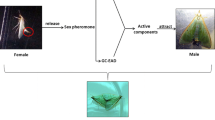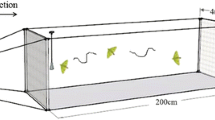Abstract
Extracts of pheromone glands from female Lymantria fumida were analyzed by coupled gas chromatographic–electroantennographic detection (GC-EAD) and by coupled GC–mass spectrometry (MS). The two compounds that elicited responses from male L. fumida antennae were identified as cis-7,8-epoxy-2-methyloctadecane (disparlure) and 2-methyl-Z7-octadecene (2me-Z7–18Hy). Field experiments in northern Japan demonstrated that synthetic (7R,8S)-cis-7,8-epoxy-2-methyloctadecane [(+)-disparlure] and 2me-Z7–18Hy are synergistic sex pheromone components of L. fumida. (7S,8R)-cis-7,8-Epoxy-2-methyloctadecane [(−)-disparlure] had no behavioral effect on male L. fumida. Traps baited with (+)-disparlure and 2me-Z7–18Hy captured male L. fumida between 21:00 and 24:00 hr, whereas traps baited with (+)-monachalure [(7R,8S)-cis-7,8-epoxy-octadecane], (+)-disparlure and 2me-Z7–18Hy attracted males of the nun moth, L. monacha L., between 02:00 and 04:00 hr. Both temporal separation of pheromonal communication and specificity of pheromone blends seem to contribute to the reproductive isolation of sympatric and coseasonal L. fumida and L. monacha.
Similar content being viewed by others

REFERENCES
Arn, H., StÄdler, E., and Raushcer, S. 1975. The electroantennographic detector-a selective and sensitive tool in the gas chromatographic analysis of insect pheromones. Z. Naturforsch. 30c:722-725.
Beroza, M., Katagiri, K., Iwata, Z., Ishizuka, H., Suzuki, S., and Bierl, B. A. 1973. Disparlure and analogues as attractants for two Japanese lymantriid moths. Environ. Entomol. 2:966.
Bierl, B. A., Beroza, M., and Collier, C. W. 1970. Potent sex attractant of the gypsy moth: Its isolation, identification and synthesis. Science 170:87-89.
Bierl, B. A., Beroza, M., Adler, V. E., Kasang, G., SchrÖter, H., and Schneider, D. 1975. The presence of disparlure, the sex pheromone of the gypsy moth, in the female nun moth. Z. Naturforsch. 30c:672-675.
CardÉ, R. T., Roelofs, W. L., and Doane, C. C. 1973. Natural inhibitor of the gypsy moth sex attractant. Nature 241:474-475.
CardÉ, R. T., Doane, C. C., Granett, J., Hill, A. S., Kochansk, Y. J., and Roelofs, W. L. 1977a. Attractancy of racemic disparlure and certain analogues to male gypsy moths and the effect of trap placement. Environ. Entomol. 6:765-767.
CardÉ, R. T., Doane, C. C., Baker, T. C., Iwaki, S., and Marumo, S. 1977b. Attractancy of optically active pheromone for male gypsy moth. Environ. Entomol. 6:768-772.
Dool, H. van den, and Kratz, P. D. 1963. A generalization of the retention index system including linear temperature programmed gas-liquid partition chromatography. J. Chromatogr. 2:463-471.
Grant, G. G., Langevin, D., Liska, J., Kapitola, P., and Chong, J. M. 1996. Olefin inhibitor of gypsy moth, Lymantria dispar, is a synergistic pheromone component of nun moth, L. monacha. Naturwissenschaften 83:328-330.
Gray, T. G., Slessor, K. N., Shepherd, R. F., Grant, G. G., and Manville, J. F. 1984. European pine shoot moth, Rhyacionia buoliana (Lepidoptera: Tortricidae): Identification of additional pheromone components resulting in an improved lure. Can. Entomol. 116:1525-1532.
Gries, G., Gries, R., Khaskin, G., Slessor, K. N., Grant, G. G., Liska, J., and Kapitola, P. 1996. Specificity of nun and gypsy moth sexual communication through multiple-component pheromone blends. Naturwissenschaften 83:382-385.
Gries, G., Gries, R., and Schaefer, P. 1997a. Pheromone blend attracts nun moth, Lymantria monacha (L.) (Lepidoptera: Lymantriidae) in Japan. Can. Entomol. 129:1177-1178.
Gries, R., Holden, D., Gries, G., Wimalaratne, P. D. C., Slessor, K. N., and Sanders, C. 1997b. 3Z-cis-6,7-cis-9,10-Di-epoxy-heneicosene: Novel class of lepidopteran pheromone. Naturwissenschaften 84:219-221.
Gries, G., Gries, R., Schaefer, P. W., Gotoh, T., and Higashiura, Y. 1999. Sex pheromone components of pink gypsy moth, Lymantria mathura. Naturwissenschaften. 86:235-238.
Hansen, K. 1984. Discrimination and production of disparlure enantiomers by the gypsy moth and the nun moth. Physiol. Entomol. 9:9-18.
Inoue, H. 1957. A revision of the Japanese Lymantriidae (II). Jpn. J. Med. Sci. Biol. 10:187-219.
Klimetzek, D., Loskant, G., VitÉ, J. P., and Mori, K. 1976. Disparlure: Differences in pheromone perception between gypsy moth and nun moth. Naturwissenschaften 63:581-582.
Miller, J. R., Mori, K., and Roelofs, W. L. 1977. Gypsy moth field trapping and electroantennogram studies with pheromone enantiomers. J. Insect Physiol. 23:1447-1453.
Plimmer, J. R., Schwalbe, C. P., Paszek, E. C., Bierl, B. A., Webb, R. E., Marumo, S., and Iwakim, S. 1977. Contrasting effects of (+) and (−) enantiomers of disparlure for trapping native populations of the gypsy moth in Massachusetts. Environ. Entomol. 6:518-522.
Sato, H. 1979. Ecology and control of Lymantria fumida. Annu. Rept. Iwate Forest Exp. Stn., Morioka 12:27-34 (in Japanese).
Zar, J. H. 1984. Biostatistical Analysis. Prentice-Hall, Englewood Cliffs, New Jersey, 718 pp.
Author information
Authors and Affiliations
Rights and permissions
About this article
Cite this article
Schaefer, P.W., Gries, G., Gries, R. et al. Pheromone Components and Diel Periodicity of Pheromonal Communication in Lymantria fumida . J Chem Ecol 25, 2305–2312 (1999). https://doi.org/10.1023/A:1020873807864
Issue Date:
DOI: https://doi.org/10.1023/A:1020873807864



